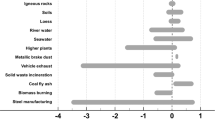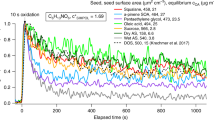Abstract
Small differences in natural isotope ratios between two compounds can be measured easily and with high precision by using mass spectrometers fitted with double (or triple) ion collectors and dual inlet systems equipped for rapid switching between reference and sample1–3. The parameter used to describe these differences in natural 15N abundance is:

where R is the isotopic ratio of m/z = 29(14N15N+) to m/z = 28(14N14N+). Although an international standard for nitrogen has not yet been defined, atmospheric N2 had been chosen through practical experience, even before the worldwide homogeneity of its isotopic composition was demonstrated4–7. However, the presence of argon (≃1%) in purified air samples may, in some circumstances, modify the apparent isotope ratio of atmospheric N2. Two different mass spectrometers in our laboratory have been used to assess the magnitude of this ‘argon effect’, which seems to be essentially an instrumental, presumably pressure-related, effect. Therefore, on mass spectrometers showing this argon effect it is imperative that a correction be applied to measurements of δ15N of atmospheric N2. However, in some circumstances (different mass spectrometers, different tuning of the same instrument) this effect can be non-existent or negligible and might require no correction whatsoever.
This is a preview of subscription content, access via your institution
Access options
Subscribe to this journal
Receive 51 print issues and online access
$199.00 per year
only $3.90 per issue
Buy this article
- Purchase on Springer Link
- Instant access to full article PDF
Prices may be subject to local taxes which are calculated during checkout
Similar content being viewed by others
References
Nier, A. O. Rev. Scient. Instrum. 18, 398–411 (1947).
McKinney, C. R., McCrea, J. M., Epstein, S., Allen, H. A. & Urey, M. C. Rev. Scient. Instrum. 21, 724–730 (1950).
Bridger, N. I., Craig, R. D. & Sercombe, J. S. F. Adv. Mass Spectrom. 6, 365–375 (1974).
Dole, M. et al. Geochim. cosmochim. Acta, 6, 65–78 (1954).
Junk, G. & Svec, H. J. Geochim. cosmochim. Acta 14, 234–243 (1958).
Sweeney, R. E., Liu, K. K. & Kaplan, I. R. DSIR Bull. 220, 9–26 (1978).
Mariotti, A. Nature 303, 685–687 (1983).
Mariotti, A., Mariotti, F. & Amarger, N. Physiol. Vég. 21, 279–291 (1983).
Heaton, T. H. E., Talma, A. S. & Vogel, J. C. J. Hydrol. 62, 243–262 (1983).
Mariotti, A. thesis, Mém. Sci. Terre, Univ. Pierre et Marie Curie, Paris, No. 82–13 (1982).
Gonfiantini, R. Nature 271, 534–536 (1978).
Author information
Authors and Affiliations
Rights and permissions
About this article
Cite this article
Mariotti, A. Natural 15N abundance measurements and atmospheric nitrogen standard calibration. Nature 311, 251–252 (1984). https://doi.org/10.1038/311251a0
Received:
Accepted:
Issue Date:
DOI: https://doi.org/10.1038/311251a0
This article is cited by
-
13C analysis of cow tail hair and farm slurry can be used to implicitly distinguish between different dairy production systems
Ecological Processes (2023)
-
The Physio-molecular Responses of Bread Wheat (Triticum aestivum L.) Induced by Coexisting Phalaris minor Retz. Under Nitrate-limiting Conditions: Perspectives of Kin and Non-kin Recognition
Journal of Soil Science and Plant Nutrition (2023)
-
Physio-molecular traits of contrasting bread wheat genotypes associated with 15N influx exhibiting homeolog expression bias in nitrate transporter genes under different external nitrate concentrations
Planta (2022)
-
Low nitrogen use efficiency and high nitrate leaching in a highly fertilized Coffea arabica–Inga densiflora agroforestry system: a 15N labeled fertilizer study
Nutrient Cycling in Agroecosystems (2013)
-
Factors controlling nitrate concentrations in surface waters of an artificially drained agricultural watershed
Landscape Ecology (2013)
Comments
By submitting a comment you agree to abide by our Terms and Community Guidelines. If you find something abusive or that does not comply with our terms or guidelines please flag it as inappropriate.



